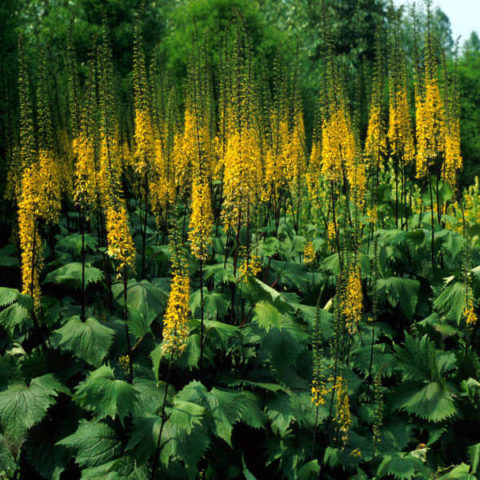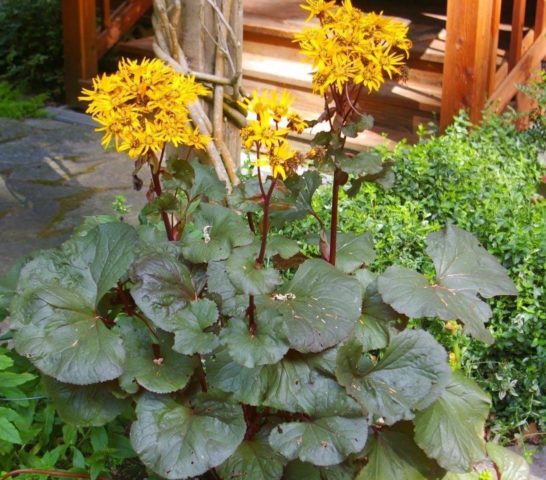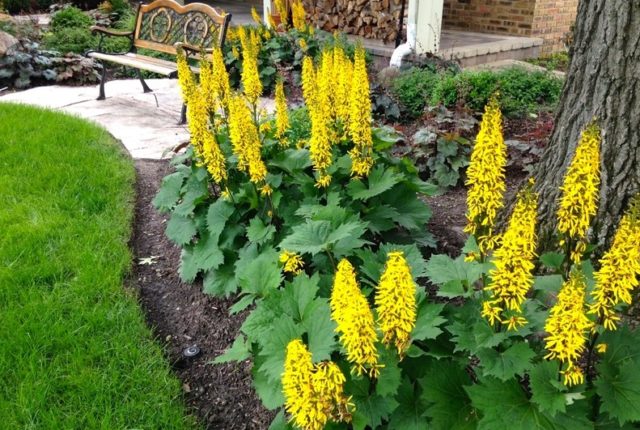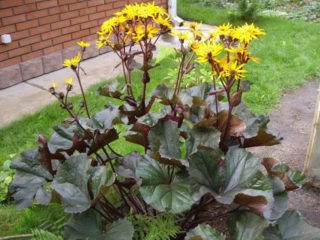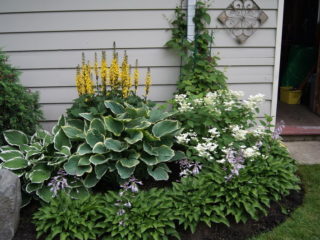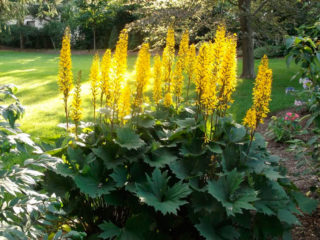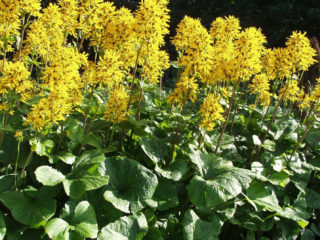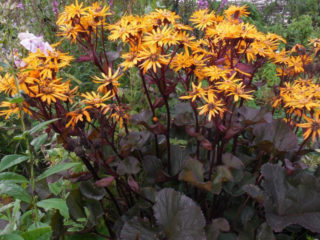Content
Buzulnik Brit Marie Crawford is suitable for decorating a garden: it is unpretentious, tolerates shaded areas well, and does not require frequent weeding and watering. The large leaves of the plant are the main decoration of the flower. They can reach 30 cm in diameter. Even a novice florist can grow Brit Marie Crawford's buzulnik.
Description of the Britt-Marie Crawford buzulnik
Buzulnik Brit Marie Crawford is a tall perennial of the Asteraceae family with large, jagged, rounded leaves growing directly from the basal rosette. The outer side, clearly cut with burgundy veins, is dark green, and the inner side is purple. Buzulnik Brit Marie Crawford blooms for 1 month - in August. Its juicy yellow or orange flowers, up to 10 cm in diameter, are collected in corymbose inflorescences. The shape resembles a chamomile.

When placing on the site, it is necessary to take into account that the buzulnik grows up to 1-1.5 m in height
The culture has another name - Ligularia serrata.The Brit Marie Crawford variety is winter-hardy, can withstand frosts down to -30 °C, quickly acclimatizes, and is distributed wild in China and southern Europe.
Application in landscape design
Buzulnik is an excellent option for the design of any site. It is used:
- as a ground cover plant;
- as an accenting element of landscape decor;
- in the form of a central element of a flower garden composition;
- in group and single plantings.
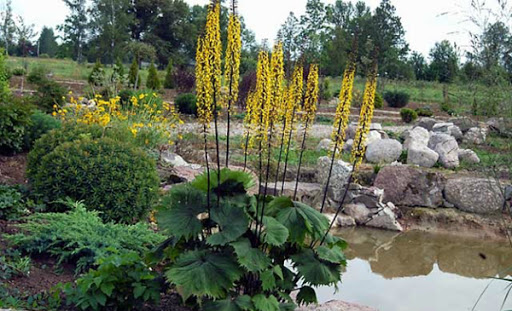
Ligularia frames artificial ponds and garden paths, emphasizing the façade of the house
Buzulnik is indispensable as decoration and camouflage for fences, utility blocks, uneven areas, hills, lowlands and other problem areas on the site.
Landscape designers advise combining the plant with the following crops:
- primrose;
- tulip;
- snake mountaineer;
- lungwort;
- meadowsweet.

The best way to decorate empty spaces in the garden is to plant buzulnik
Features of reproduction
The Brit Marie Crawford variety is propagated in two ways:
- Seeds - This method is rarely used. Seedlings grown from seeds, after transplanting into a flowerbed, will bloom no earlier than after 3 years. Not every gardener is willing to wait that long. The seeds are collected directly from the bush and dried. Sowing is carried out in October-November, deepening 1-2 mm into the ground. The seeds will sprout in the spring. In May, when the seedlings have become stronger, you can transplant them into open ground.
- Dividing the bush. The material used is a plant no younger than 5 years old. There is no need to dig it up entirely. For propagation, it is enough to cut off a strong, disease-free shoot with several buds. The sections are disinfected in a manganese solution and planted in a hole prepared in advance, fertilized with humus. The seedling is well watered.Reproduction by dividing the bush can be carried out at any time in the fall or spring), layering of buzulnik easily takes root. But the best moment is considered to be spring - a period of active growth.
Planting and care
Violation of simple rules of care slows down the growth and development of culture. Caring for Brit Marie Crawford's buzulnik (pictured) is not difficult. It is enough to water it once a week.
In spring, it is recommended to loosen and weed the soil around the bush, then cover it with a layer of mulch. Summer care consists of systematic feeding and watering, especially in dry weather.
Only plants planted on depleted soils need feeding. If the soil is fertile and was fertilized when planting the flower, fertilizing may not be necessary.
In the fall, cut off the foliage, mulch the ground around and cover with leaves, spruce branches or spunbond. Faded inflorescences are removed immediately, so the bush will retain its decorative properties longer. If it is necessary to collect seed material, 1-2 inflorescences are left on the bush. Buzulnik Brit Marie Crawford itself throws out seeds, they germinate a short distance from the mother plant.
Recommended timing
It is permissible to plant a flower in the ground no earlier than May. At this time, he adapts more easily and gets more opportunities for growth and development.
Site selection and soil preparation
It is advisable to plant Buzulnik Brit Marie Crawford in areas with fertile soil, preferably clay, to retain water at the roots. On sandy and sandy loam soils the plant will die. Buzulnik grows well in lowlands, simultaneously hiding and decorating uneven landscapes. The presence of artificial ponds on the site is welcome; placing a flower around them is the best place for planting.
Buzulnik Brit Marie Crawford loves sunlight and grows well in sunny areas. When placed correctly, its leaves and inflorescences have a more saturated color.

Direct rays of the sun are contraindicated for the plant; there should be a shadow on one side
It can develop normally in an open place only with regular watering (2 times a week).
Landing algorithm
The crop should be planted in dug up and loosened soil. Its moisture at first is the main condition for the normal development of the seedling.
Landing algorithm:
- Dig the area to the depth of a spade bayonet. The root collar of the Brit Marie Crawford buzulnik is located very close to the surface.
- At a distance of 70 cm, make holes measuring 40x40 cm.
- Pour generously with warm water.
- Add ash, humus and superphosphate as fertilizer.Attention! Superphosphate, humus and ash (1:1:1/4) are prepared for each seedling.
- Mix the fertilizer with the soil inside the hole.
- Place the buzulnik seedling in the hole, cover it with soil and lightly compact the top with your palms. The root collar should not be buried, it should be slightly above the ground.

The strongest of the seedlings planted in May can already please with color in August
After finishing planting, the plants must be watered abundantly.
If the Brit Marie Crawford buzulnik blooms at the time of transplanting into the ground, experts recommend removing the inflorescences, and with them 1/3 of the leaves. The rest of the landing is carried out the same way.
Watering and fertilizing schedule
In spring and summer, the flower needs abundant watering. Huge leaves quickly lose moisture, and the exposed root collar requires moisture.
In rainy summers, watering can be canceled. The same applies to buzulnik planted near a reservoir.
If all fertilizers were applied when planting the seedlings, the plant will need fertilizing no earlier than after 2 years. During the period of active growth, the buzulnik is watered abundantly, then cow manure dissolved in water is added under each bush (at a concentration of 1:10). Lightly sprinkle wood ash on top.
The repeated procedure is carried out in May-July, adding 0.5 buckets of humus to each plant. Only bushes growing on infertile soils can be fertilized ahead of schedule.
Loosening and mulching
For the normal development of Brit Marie Crawford's buzulnik, it is necessary to provide it with regular air supply to the roots, so each time after watering the flower must be loosened. To facilitate the process, you can mix the top layer of soil with peat, this will make the soil lighter and looser.
Weeding is necessary only in the first 4 months after planting; in the future, the Brit Marie Crawford buzulnik does not need it. Strongly growing leaves make it difficult for weeds to grow and it is always clean underneath.
Mulching the root area allows you to keep the soil moist longer, which is very important for plants planted in open sunny areas. For mulching, hay, dry leaves, sawdust, and humus are suitable.
Trimming
Brit Marie Crawford's buzulnik is pruned after flowering to ensure the shoots and leaves receive nutrients. If it is not carried out, then the wilted buds will take away the nutrients from the plant, the growth of green mass will stop, which means the flower will not be able to survive the winter. The buds are removed with garden shears, the shoots are shortened by 1/3, dry or damaged leaves are removed and burned.
Preparing for winter
Before frosts, Brit Marie Crawford recommends covering the buzulnik for the winter, despite its high cold resistance. The ground part of the flower is cut off and covered.

Frost-resistant buzulnik Brit Marie Crawford needs cover with foliage and spruce branches
It is better to additionally cover plants grown in areas with cold climates with spunbond. Additional shelter is also used in all regions where little snow falls in winter.
Diseases and pests
Buzulnik Brit Marie Crawford is very resistant to most defeats. Only powdery mildew and slugs can cause significant damage to it.
Slugs attack young leaves and stems. To get rid of them, superphosphate or crushed nutshells are scattered on the ground. You can collect parasites manually by digging up the bushes and pouring ash into the resulting holes.
When powdery mildew appears on the leaves, buzulnik is treated with fungicides, manganese solution or colloidal sulfur (1%).
Conclusion
Buzulnik Brit Marie Crawford is an interesting option for decorating a site.He will hide problem areas while turning attention to himself. The flower grows in one place for a long time. It is unpretentious in care, which is only beneficial for beginning flower growers.
